课程英文名称:Management Information System
《管理信息系统》教学大纲
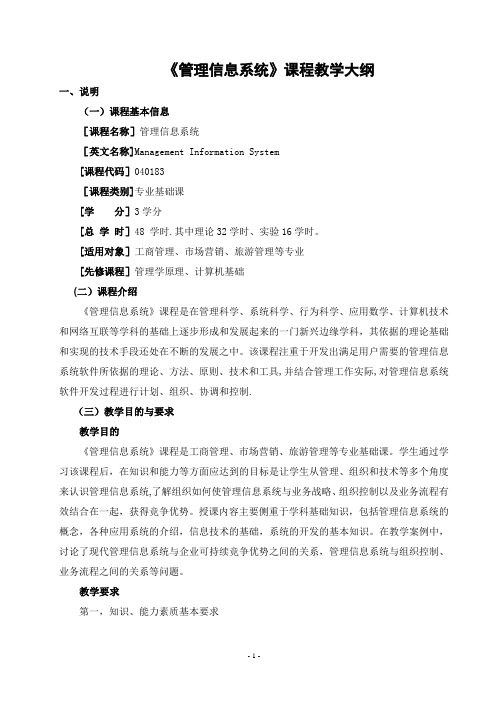
《管理信息系统》课程教学大纲一、说明(一)课程基本信息[课程名称]管理信息系统[英文名称]Management Information System[课程代码]040183[课程类别]专业基础课[学分]3学分[总学时]48 学时.其中理论32学时、实验16学时。
[适用对象]工商管理、市场营销、旅游管理等专业[先修课程]管理学原理、计算机基础(二)课程介绍《管理信息系统》课程是在管理科学、系统科学、行为科学、应用数学、计算机技术和网络互联等学科的基础上逐步形成和发展起来的一门新兴边缘学科,其依据的理论基础和实现的技术手段还处在不断的发展之中。
该课程注重于开发出满足用户需要的管理信息系统软件所依据的理论、方法、原则、技术和工具,并结合管理工作实际,对管理信息系统软件开发过程进行计划、组织、协调和控制.(三)教学目的与要求教学目的《管理信息系统》课程是工商管理、市场营销、旅游管理等专业基础课。
学生通过学习该课程后,在知识和能力等方面应达到的目标是让学生从管理、组织和技术等多个角度来认识管理信息系统,了解组织如何使管理信息系统与业务战略、组织控制以及业务流程有效结合在一起,获得竞争优势。
授课内容主要侧重于学科基础知识,包括管理信息系统的概念,各种应用系统的介绍,信息技术的基础,系统的开发的基本知识。
在教学案例中,讨论了现代管理信息系统与企业可持续竞争优势之间的关系,管理信息系统与组织控制、业务流程之间的关系等问题。
教学要求第一,知识、能力素质基本要求知识要求:掌握管理信息化建设中的管理信息系统开发从系统规划、分析、设计到实施各个阶段的基本理论知识和基本方法。
能力素质要求:掌握信息化管理建设过程中的信息系统开发步骤、具有运用所学管理信息系统知识挖掘出企业系统应具备的功能的能力.第二,教学模式基本要求课程设计是本门课程的一个特点,所以,将课堂理论教学、案例启发教学、课外调研、课后指导等有机结合起来,提高教学效率。
MIS教学大纲
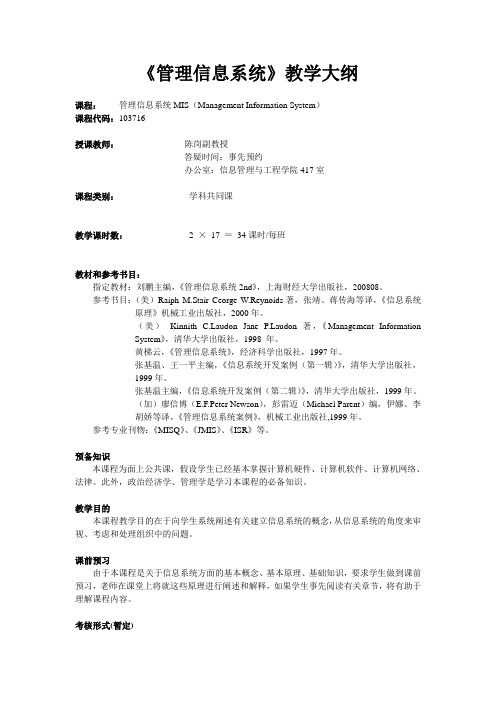
《管理信息系统》教学大纲课程:管理信息系统MIS(Management Information System)课程代码:103716授课教师:陈岗副教授答疑时间:事先预约办公室:信息管理与工程学院417室课程类别:学科共同课教学课时数: 2 ×17 =34课时/每班教材和参考书目:指定教材:刘鹏主编,《管理信息系统2nd》,上海财经大学出版社,200808。
参考书目:(美)Raiph M.Stair Ceorge W.Reynoids著,张靖、蒋传海等译,《信息系统原理》机械工业出版社,2000年。
(美)Kinnith udon Jane udon著,《Management InformationSystem》,清华大学出版社,1998 年。
黄梯云,《管理信息系统》,经济科学出版社,1997年。
张基温、王一平主编,《信息系统开发案例(第一辑)》,清华大学出版社,1999年。
张基温主编,《信息系统开发案例(第二辑)》,清华大学出版社,1999年。
(加)廖信博(E.F.Peter Newson),彭雷迈(Michael Parent)编,伊娜、李胡娇等译,《管理信息系统案例》,机械工业出版社,1999年。
参考专业刊物:《MISQ》、《JMIS》、《ISR》等。
预备知识本课程为面上公共课,假设学生已经基本掌握计算机硬件、计算机软件、计算机网络、法律。
此外,政治经济学、管理学是学习本课程的必备知识。
教学目的本课程教学目的在于向学生系统阐述有关建立信息系统的概念,从信息系统的角度来审视、考虑和处理组织中的问题。
课前预习由于本课程是关于信息系统方面的基本概念、基本原理、基础知识,要求学生做到课前预习,老师在课堂上将就这些原理进行阐述和解释,如果学生事先阅读有关章节,将有助于理解课程内容。
考核形式(暂定)我们将各章节内容适时举行课堂讨论和案例介绍。
结合讨论课后可能会要求写小论文一篇,必须在指定日期之前提交。
管理信息系统课程教学大纲
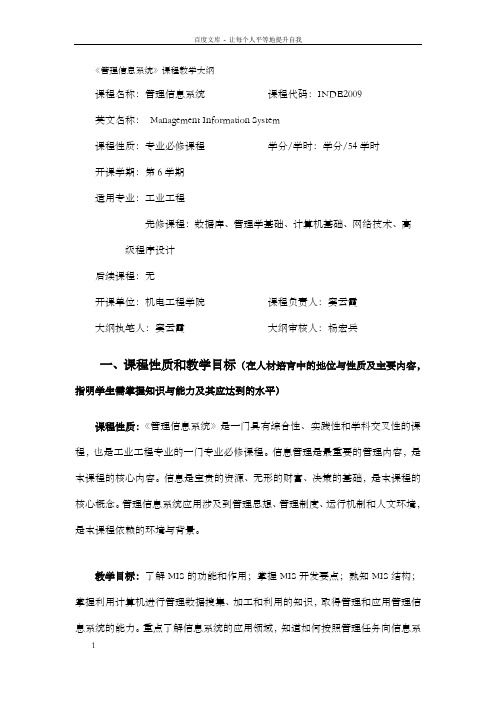
《管理信息系统》课程教学大纲课程名称:管理信息系统课程代码:INDE2009英文名称:Management Information System课程性质:专业必修课程学分/学时:学分/54学时开课学期:第6学期适用专业:工业工程先修课程:数据库、管理学基础、计算机基础、网络技术、高级程序设计后续课程:无开课单位:机电工程学院课程负责人:窦云霞大纲执笔人:窦云霞大纲审核人:杨宏兵一、课程性质和教学目标(在人材培育中的地位与性质及主要内容,指明学生需掌握知识与能力及其应达到的水平)课程性质:《管理信息系统》是一门具有综合性、实践性和学科交叉性的课程,也是工业工程专业的一门专业必修课程。
信息管理是最重要的管理内容,是本课程的核心内容。
信息是宝贵的资源、无形的财富、决策的基础,是本课程的核心概念。
管理信息系统应用涉及到管理思想、管理制度、运行机制和人文环境,是本课程依赖的环境与背景。
教学目标:了解MIS的功能和作用;掌握MIS开发要点;熟知MIS结构;掌握利用计算机进行管理数据搜集、加工和利用的知识,取得管理和应用管理信息系统的能力。
重点了解信息系统的应用领域,知道如何按照管理任务向信息系统开发人员提出设计要求,并配合他们成立信息系统,为管理决策服务。
二、课程教学内容及学时分派(含课程教学、自学、作业、讨论等内容和要求,指明重点内容和难点内容。
重点内容:;难点内容:∆)1、信息系统概述(6学时)1.1信息化与管理1.2系统与信息系统1.3管理信息系统1.4管理信息系统与现代管理方式1.5管理信息系统的发展趋势1.6组织与信息系统;1.7信息系统对组织的影响1.8信息系统应用中的管理挑战1.9企业信息系统管理部门的成立目标及要求:1)了解信息系统的概念,掌握信息管理是管理信息系统的核心内容;2)掌握管理信息系统的发展趋势3)掌握了解信息系统对组织的影响。
讨论内容:信息系统在现代企业中的地位。
2、管理信息系统的基础及重要性(3学时)2.1通信、互联网与无线技术2.2商务智能基础2.3实现卓越运营和亲近客户2.4数字化市场与数字化商品目标及要求:1)了解现今商业世界的通信和网络;2)了解通信网络、互联网和企业网络,了解无线革命给企业带来的影响;3)掌握商务智能基础,了解数据库管理系统能够提高公司绩效和决策;4)了解现代ERP系统、SCM系统和CRM系统;5)了解电子商务及移动电子商务。
中山大学信息管理学本科课程
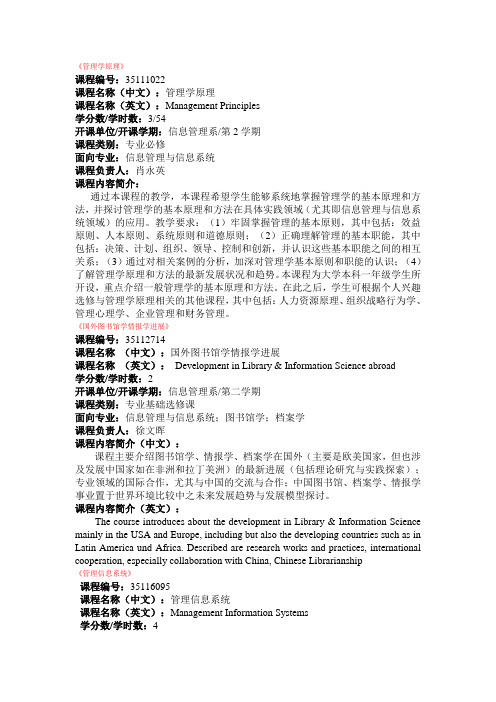
《管理学原理》课程编号:35111022课程名称(中文):管理学原理课程名称(英文):Management Principles学分数/学时数:3/54开课单位/开课学期:信息管理系/第2学期课程类别:专业必修面向专业:信息管理与信息系统课程负责人:肖永英课程内容简介:通过本课程的教学,本课程希望学生能够系统地掌握管理学的基本原理和方法,并探讨管理学的基本原理和方法在具体实践领域(尤其即信息管理与信息系统领域)的应用。
教学要求:(1)牢固掌握管理的基本原则,其中包括:效益原则、人本原则、系统原则和道德原则;(2)正确理解管理的基本职能,其中包括:决策、计划、组织、领导、控制和创新,并认识这些基本职能之间的相互关系;(3)通过对相关案例的分析,加深对管理学基本原则和职能的认识;(4)了解管理学原理和方法的最新发展状况和趋势。
本课程为大学本科一年级学生所开设,重点介绍一般管理学的基本原理和方法。
在此之后,学生可根据个人兴趣选修与管理学原理相关的其他课程,其中包括:人力资源原理、组织战略行为学、管理心理学、企业管理和财务管理。
《国外图书馆学情报学进展》课程编号:35112714课程名称(中文):国外图书馆学情报学进展课程名称(英文):Development in Library & Information Science abroad学分数/学时数:2开课单位/开课学期:信息管理系/第二学期课程类别:专业基础选修课面向专业:信息管理与信息系统;图书馆学;档案学课程负责人:徐文晖课程内容简介(中文):课程主要介绍图书馆学、情报学、档案学在国外(主要是欧美国家,但也涉及发展中国家如在非洲和拉丁美洲)的最新进展(包括理论研究与实践探索);专业领域的国际合作,尤其与中国的交流与合作;中国图书馆、档案学、情报学事业置于世界环境比较中之未来发展趋势与发展模型探讨。
课程内容简介(英文):The course introduces about the development in Library & Information Science mainly in the USA and Europe, including but also the developing countries such as in Latin America und Africa. Described are research works and practices, international cooperation, especially collaboration with China, Chinese Librarianship《管理信息系统》课程编号:35116095课程名称(中文):管理信息系统课程名称(英文):Management Information Systems学分数/学时数:4开课单位/开课学期:信息管理系,第七学期课程类别:专业必修面向专业:信息管理与信息系统课程负责人:路永和课程内容简介(中文):系统分析与设计概述:系统参与者,信息系统构架块,信息系统开发,项目管理。
常用课程的英文翻译

文献检索 document.tion Retrieval
数据库概论 Introduction to Database
网络原理 Principles of Network
人工智能 Artificial Intelligence
Finance 财政学
Financial Accounting 财务会计
Fine Arts 美术
Functions of a Complex Variable 单复变函数
Functions of Complex Variables 复变函数
Functions of Complex Variables & Integral Transformations 复变函数与积分变
数字电子技术 Digital Electrical Technique
电磁场 Electromagnetic Field
微机原理 Principle of Microcomputer
企业管理 Business Management
专业英语 Specialized English
可编程序控制技术 Controlling Technique for Programming
Advanced Mathematics 高等数学
Advanced Numerical Analysis 高等数值分析
Algorithmic Language 算法语言
Analogical Electronics 模拟电子电路
Artificial Intelligence Programming 人工智能程序设计
经济类各专业课程英文名称

22
必修
投资银行理论与实务
TheoryandPracticesof InvestmentBank
孙浩
23
必修
外汇业务与管理(I)
FOREXOperation& Management(I)
廖尧麟
24
必修
财务管理(I)
FinancialManagement(I)
严 俊
25
限选
市场营销(II)
Marketing(Ⅱ)
阮建军
9
必修
经济法
EconomicLaws
王新周
10
必修
国际贸易(I)
International Trade(Ⅰ)
傅江景
11
必修
管理学(II)
Management(Ⅱ)
何苏华
12
必修
国际贸易实务(I)
Practices ofInternationalTrade(Ⅰ)
李军
13
必修
市场营销(II)
Marketing(Ⅱ)
Practices ofInternationalTrade(II)
郭影帆
31
任选
金融研究专题讲座
Special Topics on Finance Studies
尹祖宁
32
任选
国际经济与贸易前沿专题
SpecialTopicsonInternationalEconomy&Trade
罗良忠
33
任选
WTO(金融)专题
陆明祥
《会计学专业》课程英文名称
课程
类别
序号
课程性质
课程名称
课程英文名称
(完整)《管理信息系统》教学大纲

《管理信息系统》教学大纲一、课程基本信息课程中文名称:管理信息系统课程英文名称:Management Information System课程编码:20000058课程类型:学科基础课总学时:54 理论学时:30 上机学时:24学分: 3适用专业:经济管理各专业先修课程:《管理学》、《计算机基础》、《应用数学》《运筹学》《数据库系统》《计算机网络》开课院系:经济管理学院电子商务教研室二、课程的性质与任务本课程是一门专业课程,它是一门新的学科,是多科交叉的边缘科学。
是利用计算机技术、应用数学、管理理论、运筹学等相关学科的理论,研究管理信息系统的规划、设计、实施等一系列过程,从而为管理者提供决策依据的学科.本课程是管理学等门类各专业的专业课。
三、教学基本要求1、掌握管理信息系统的有关概念.2、掌握管理信息系统的开发的步骤和相应内容3、理解面向对象的系统开发方法.4、能开发一个简单的管理信息系统四、理论教学内容和基本要求第1章管理信息系统概述1。
1 信息的概念1.2 信息系统的概念及其发展1.3 信息系统和管理1.4 管理信息系统的概念1.5管理信息系统与现代管理方法1.6企业资源计划基本要求(1)掌握:数据与信息的概念,管理信息系统的概念(2)了解:物料需求计划;制造资源计划;企业资源计划第2章管理信息系统的技术基础2。
1.信息技术概述2.2.数据处理2.3.数据库技术2。
4.计算机网络技术基本要求(1)理解:计算机网络技术(2)掌握:数据库技术;实体联系模型第3章管理信息系统的战略规划和开发方法3.1管理信息系统战略规划的概念3。
2制定管理信息系统战略规划的常用方法3.3企业流程重组3。
4开发管理信息系统的方法基本要求(1)掌握:管理信息系统规划的主要方法;(2)掌握:开发管理信息系统的方法;(3)理解:管理信息系统战略规划的概念;(4)了解:教学管理信息系统总体方案第4章管理信息系统的系统分析4.1。
《管理信息系统》课程简介
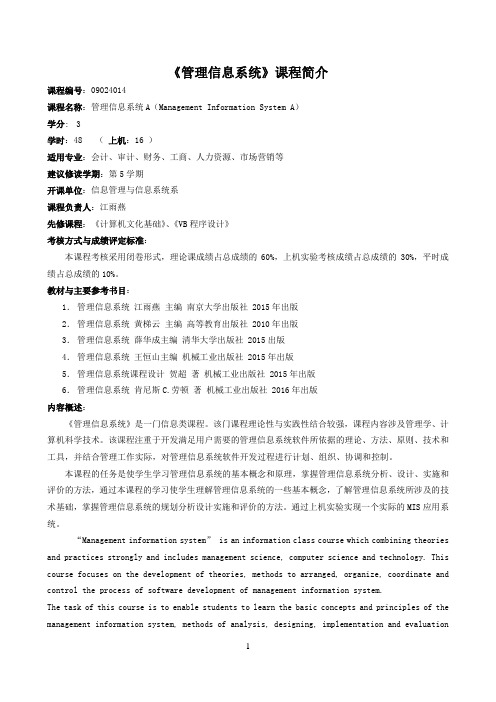
《管理信息系统》课程简介课程编号:09024014课程名称:管理信息系统A(Management Information System A)学分:3学时:48 (上机:16 )适用专业:会计、审计、财务、工商、人力资源、市场营销等建议修读学期:第5学期开课单位:信息管理与信息系统系课程负责人:江雨燕先修课程:《计算机文化基础》、《VB程序设计》考核方式与成绩评定标准:本课程考核采用闭卷形式,理论课成绩占总成绩的60%,上机实验考核成绩占总成绩的30%,平时成绩占总成绩的10%。
教材与主要参考书目:1.管理信息系统江雨燕主编南京大学出版社 2015年出版2.管理信息系统黄梯云主编高等教育出版社 2010年出版3.管理信息系统薛华成主编清华大学出版社 2015出版4.管理信息系统王恒山主编机械工业出版社 2015年出版5.管理信息系统课程设计贺超著机械工业出版社 2015年出版6.管理信息系统肯尼斯C.劳顿著机械工业出版社 2016年出版内容概述:《管理信息系统》是一门信息类课程。
该门课程理论性与实践性结合较强,课程内容涉及管理学、计算机科学技术。
该课程注重于开发满足用户需要的管理信息系统软件所依据的理论、方法、原则、技术和工具,并结合管理工作实际,对管理信息系统软件开发过程进行计划、组织、协调和控制。
本课程的任务是使学生学习管理信息系统的基本概念和原理,掌握管理信息系统分析、设计、实施和评价的方法,通过本课程的学习使学生理解管理信息系统的一些基本概念,了解管理信息系统所涉及的技术基础,掌握管理信息系统的规划分析设计实施和评价的方法。
通过上机实验实现一个实际的MIS应用系统。
“Management information system” is an information class course which combining theories and practices strongly and includes management science, computer science and technology. This course focuses on the development of theories, methods to arranged, organize, coordinate and control the process of software development of management information system.The task of this course is to enable students to learn the basic concepts and principles of the management information system, methods of analysis, designing, implementation and evaluationof management information system and understand the basic concepts of management information systems, the based knowledge of management information system, to master the methods of planning, analysis, design, implementation and evaluation of management information system. Base on experiments to implement an actual management information application system.《管理信息系统》教学大纲课程编号:09024014课程名称:管理信息系统A/(Management Information System A)学分:3学时:48 (上机:16 )适用专业:会计、审计、财务、工商、人力资源、市场营销等建议修读学期:第5学期开课单位:信息管理与信息系统系课程负责人:江雨燕先修课程:《计算机文化基础》、《VB程序设计》一、课程性质、目的与任务《管理信息系统A》是一门信息类课程,是信息管理与信息系统、工业工程、物流工程、造价工程、会计、审计、财务、工商、人力资源、市场营销等专业的一门重要的专业基础课,是信息管理与信息系统专业必修的主干核心课。
信息管理系统 management information system(第九版英文原版).

LearningObjectives Web Link VideoManagementWrap-up Managing the Digital FirmCase Study: DaimlerChrysler’s Agile Supply ChainSection 1.1: Why Information Systems?Why Information Systems MatterHow Much Does IT Matter?Why IT Now? Digital Convergence and the Changing Business EnvironmentSection 1.2: Perspectives on Information SystemsWhat Is an Information System?Window on Organizations:Cemex: A Digital Firm in the MakingWindow on Technology: UPS Competes Globally with Information TechnologyIt Isn’t Just Technology: A Business Perspective on Information SystemsDimensions of Information SystemsSection 1.3: Contemporary Approaches to Information SystemsTechnical ApproachBehavioral ApproachApproach of This Text: Sociotechnical SystemsSection 1.4: Learning to Use Information Systems: New Opportunities with TechnologyThe Challenge of Information Systems: Key Management IssuesIntegrating Text with Technology: New Opportunities for LearningLearning SupplementsMake IT Your BusinessSummaryKey TermsReview QuestionsDiscussion QuestionsApplication Software Exercise: Database Exercise: Adding Value to Information for ManagementDecision Making.Dirt Bikes U.S.A.: Preparing a Management Overview of the CompanyElectronic Commerce Project: Analyzing Shipping CostsGroup Project: Analyzing a Business SystemCase Study: Dollar General: Heavy on Organization, Light on SystemsLearningObjectives Web Link Video Management Wrap-upLearningObjectives Web Link VideoManagementWrap-up Information Systems in the EnterpriseCase Study: Fast Fashion, Hot SystemsSection 2.1: Major Types of Systems in OrganizationsDifferent Kinds of SystemsFour Major Types of SystemsRelationship of Systems to One AnotherSection 2.2: Systems from a Functional PerspectiveSales and Marketing SystemsManufacturing and Production SystemsWindow on Organizations:Product Life Cycle Management Systems:Faster Products, Faster ProcessesFinance and Accounting SystemsHuman Resources SystemsSection 2.3: Integrating Functions and Business Processes: Introduction to Enterprise ApplicationsBusiness Processes and Information SystemsSystems for Enterprise-Wide Process IntegrationOverview of Enterprise ApplicationsWindow on Technology: Haworth Overhauls Supply Chain ManagementSection 2.4: Management Opportunities, Challenges, and SolutionsOpportunitiesManagement ChallengesSolution GuidelinesLearning SupplementsMake IT Your BusinessSummaryKey TermsReview QuestionsDiscussion QuestionsApplication Software Exercise: Spreadsheet Exercise: Improving Supply ChainManagementDirt Bikes U.S.A.: Analyzing Financial PerformanceElectronic Business Project: Planning Transportation LogisticsGroup Project: Describing Management Decisions and SystemsCase Study: Snyder’s of Hanover: New Systems for an Old Family CompanyLearningObjectives Web Link Video Management Wrap-upPrentice Hall © 2006 | Azimuth Interactive Inc. © 2006LearningObjectives Web Link VideoManagementWrap-up Information Systems, Organizations, Management, and StrategyCase Study: Gallo Winery Leads by Blending Business with TechnologySection 3.1: Organizations and Information SystemsWhat Is an Organization?Common Features of OrganizationsUnique Features of OrganizationsWindow on Organizations:E-Commerce North and South of the BorderOrganizing the IT FunctionSection 3.2: How Information Systems Impact Organizations and Business Firms Economic ImpactsOrganizational and Behavioral ImpactsThe Internet and OrganizationsSection 3.3: The Impact of IT on Management Decision MakingHow IT Affects Management Decision MakingThe Role of Managers in OrganizationsModels of Decision MakingImplications for the Design and Understanding of Information SystemsSection 3.4: Information Systems and Business StrategyBusiness-Level Strategy: The Value Chain ModelWindow on Technology: Hotel Loyalty Programs Become CompetitiveWeaponsFirm-Level Strategy and Information TechnologyIndustry-Level Strategy and Information Systems: Competitive Forces andNetwork EconomicsSection 3.5: Management Opportunities, Challenges, and SolutionsOpportunitiesManagement ChallengesSolution GuidelinesLearning SupplementsMake IT Your BusinessSummaryKey TermsReview QuestionsDiscussion QuestionsApplication Software Exercise: Database Exercise: Using a Database for StrategicBusiness DevelopmentDirt Bikes U.S.A.: Performing a Competitive Analysis for Dirt BikesElectronic Commerce Project: Configuring and Pricing an AutomobileGroup Project: Identifying Opportunities for Strategic Information SystemsCase Study: Can Albertsons Trounce Wal-Mart with Advanced InformationTechnology?LearningObjectives Web Link Video Management Wrap-upPrentice Hall © 2006 | Azimuth Interactive Inc. © 2006LearningObjectives Web Link VideoManagementWrap-up The Digital Firm: Electronic Business and Electronic CommerceCase Study: Corrugated Supplies: The Internet Helps a Small Company Act BigSection 4.1: Electronic Business, Electronic Commerce, and the Emerging Digital Firm Internet Technology and the Digital FirmNew Business Models and Value PropositionsSection 4.2: Electronic CommerceCategories of Electronic CommerceCustomer-Centered RetailingBusiness-to-Business Electronic Commerce: New Efficiencies andRelationshipsElectronic Commerce Payment SystemsWindow on Technology: Volkswagen Revs Up Its B2B NetworkSection 4.3: Electronic Business and the Digital FirmHow Intranets Support Electronic BusinessIntranet Applications for Electronic BusinessWindow on Organizations:CARE’s Humanitarian IntranetsBusiness Process IntegrationSection 4.4: Management Opportunities, Challenges, and SolutionsOpportunitiesManagement ChallengesSolution GuidelinesLearning SupplementsMake IT Your BusinessSummaryKey TermsReview QuestionsDiscussion QuestionsApplication Software Exercise: Spreadsheet Exercise: Analyzing a Dot-Com BusinessDirt Bikes U.S.A.: Developing an E-Commerce StrategyElectronic Commerce Project: Comparing Online Storefront Hosting ServicesGroup Project: Performing a Competitive Analysis of E-Commerce SitesCase Study: Can the Music Industry Change Its Tune?LearningObjectives Web Link Video Management Wrap-upPrentice Hall © 2006 | Azimuth Interactive Inc. © 2006LearningObjectives Web Link VideoManagementWrap-up Ethical and Social Issues in the Digital FirmCase Study: “Attention Shoppers: Background Checks for Sale”Section 5.1: Understanding Ethical and Social Issues Related to SystemsA Model for Thinking About Ethical, Social, and Political IssuesFive Moral Dimensions of the Information AgeKey Technology Trends That Raise Ethical IssuesSection 5.2: Ethics in an Information SocietyBasic Concepts: Responsibility, Accountability, and LiabilityEthical AnalysisProfessional Codes of ConductSome Real-World Ethical DilemmasSection 5.3: The Moral Dimensions of Information SystemsInformation Rights: Privacy and Freedom in the Internet AgeProperty Rights: Intellectual PropertyAccountability, Liability, and ControlSystem Quality: Data Quality and System ErrorsWindow on Technology: When Software Kills: What Happened atPanama’s National Cancer InstituteQuality of Life: Equity, Access, and BoundariesWindow on Management: Can the Spamming Monster Be Tamed?Section 5.4: Management Opportunities, Challenges, and SolutionsOpportunitiesManagement ChallengesSolution GuidelinesLearning SupplementsMake IT Your BusinessSummaryKey TermsReview QuestionsDiscussion QuestionsApplication Software Exercise: Word Processing and Web Page Development ToolExercise: Creating a Simple Web SiteDirt Bikes USA: Developing a Web Site Privacy PolicyElectronic Commerce Project: Using Internet Newsgroups for Online Market ResearchGroup Project: Developing a Corporate Ethics CodeCase Study: Security Versus Privacy: Does Terrorism Change the Debate?LearningObjectives Web Link Video Management Wrap-upPrentice Hall © 2006 | Azimuth Interactive Inc. © 2006LearningObjectives Web Link VideoManagementWrap-up IT Infrastructure and PlatformsCase Study: Hong Kong’s New World Telecommunications Prospers with a New IT InfrastructureSection 6.1: IT InfrastructureDefining IT InfrastructureLevels of IT InfrastructureEvolution of IT Infrastructure: 1950–2005Technology Drivers of Infrastructure EvolutionSection 6.2: Infrastructure ComponentsComputer Hardware PlatformsOperating System PlatformsEnterprise Software ApplicationsData Management and StorageNetworking/Telecommunications PlatformsInternet PlatformsConsulting and System Integration ServicesSection 6.3: Contemporary Hardware Platform TrendsThe Integration of Computing and Telecommunications PlatformsGrid ComputingOn-Demand Computing (Utility Computing)Autonomic ComputingWindow on Management: On-Demand Computing at Qantas Airwaysand Ford Motor Company EuropeEdge ComputingSection 6.4: Contemporary Software Platform TrendsThe Rise of Linux and Open-Source SoftwareJava Is EverywhereWindow on Technology: Two Canadian Cities Go for LinuxSoftware for Enterprise IntegrationSoftware OutsourcingSection 6.5: Management Opportunities, Challenges, and SolutionsOpportunitiesManagement ChallengesSolution GuidelinesLearning SupplementsMake IT Your BusinessSummaryKey TermsReview QuestionsDiscussion QuestionsApplication Software Exercise: Spreadsheet Exercise: Evaluating Computer Hardwareand Software OptionsDirt Bikes USA: Analyzing the Total Cost of Ownership (TCO) of Desktop SoftwareAssetsElectronic Business Project: Planning and Budgeting for a Sales ConferenceGroup Project: Evaluating Server Operating SystemsCase Study: 99 Cents Only Stores: IT Infrastructure on a BudgetLearningObjectives Web Link Video Management Wrap-upPrentice Hall © 2006 | Azimuth Interactive Inc. © 2006LearningObjectives Web Link VideoManagementWrap-up IT Infrastructure and PlatformsCase Study: Better Data Help Virgin Mobile Australia Win the Customer WarsSection 7.1: Organizing Data in a Traditional File EnvironmentFile Organization Terms and ConceptsProblems with the Traditional File EnvironmentSection 7.2: The Database Approach to Data ManagementDatabase Management SystemsTypes of DatabasesWindow on Organizations: A Database Helps P&G Manage ProductInformationSection 7.3: Creating a Database EnvironmentDesigning DatabasesDistributing DatabasesEnsuring Data QualitySection 7.4: Database TrendsMultidimensional Data AnalysisData Warehouses and Data MiningWindow on Technology: Large Data Warehouses: When Bigger IsBetterDatabases and the WebSection 7.5: Management Opportunities, Challenges, and SolutionsOpportunitiesManagement ChallengesSolution GuidelinesLearning SupplementsMake IT Your BusinessSummaryKey TermsReview QuestionsDiscussion QuestionsApplication Software Exercise: Database Exercise: Building a Relational Database fora Small BusinessDirt Bikes U.S.A.: Redesigning the Customer DatabaseElectronic Commerce Project: Searching Online DatabasesGroup Project: Creating Company-Wide Data StandardsCase Study: Database Woes Plague Homeland Security and Law EnforcementLearningObjectives Web Link Video Management Wrap-upPrentice Hall © 2006 | Azimuth Interactive Inc. © 2006LearningObjectives Web Link VideoManagementWrap-upTelecommunications, Networks, and the InternetCase Study: Okanagan-Skaha School District Does More with Less Using Networking and the InternetSection 8.1: Telecommunications and Networking in Today’s Business World The Business Telecommunications EnvironmentNetworking and Communications TrendsThe Business Value of Telecommunications and NetworkingSection 8.2: Contemporary Networking InfrastructureNetworks and Corporate InfrastructureKey Digital Networking TechnologiesPhysical Transmission MediaTypes of NetworksBroadband Network Services and TechnologiesSection 8.3: The InternetInternet Addressing, Architecture, and GovernanceInternet ServicesThe Internet and Business ValueThe World Wide webIntranets and ExtranetsNext-Generation Networks and Internet2Section 8.4: Technologies and Tools for Communication and E-BusinessE-Mail, Chat, Instant Messaging, and Electronic DiscussionsGroupware, Teamware, and Electronic ConferencingInternet TelephonyWindow on Organizations: Internet Telephones: Why Not?Virtual Private NetworksSection 8.5: Management Opportunities, Challenges, and SolutionsOpportunitiesManagement ChallengesSolution GuidelinesWindow on Management: Monitoring Employees on Networks:Unethical or Good Business?Learning SupplementsMake IT Your BusinessSummaryKey TermsReview QuestionsDiscussion QuestionsApplication Software Exercise: Spreadsheet Exercise: Analyzing Web Site VisitorsDirt Bikes U.S.A.: Using Internet Tools to Increase Efficiency and ProductivityElectronic Commerce Project: Using Web Search Engines for Business ResearchGroup Project: Identifying Strategic Opportunities for Networking TechnologyCase Study: Can REI Climb Higher with Networking and the Internet?LearningObjectives Web Link Video Management Wrap-upPrentice Hall © 2006 | Azimuth Interactive Inc. © 2006LearningObjectives Web Link VideoManagementWrap-up The Wireless RevolutionCase Study: The Boston Public Library Goes WirelessSection 9.1: The Wireless Computing LandscapeThe Wireless RevolutionBusiness Value of Wireless NetworkingWireless Transmission Media and DevicesCellular Network Standards and GenerationsMobile Wireless Standards for Web AccessSection 9.2: Wireless Computer Networks and Internet AccessBluetoothWi-FiWiMax and EV-DOWindow on Management: Wi-Fi: Starbuck’s Solution to GoSection 9.3: M-Commerce and Mobile ComputingM-Commerce Services and ApplicationsAccessing Information from the Wireless WebDigital Payment Systems and M-CommerceM-Commerce ChallengesSection 9.4: Wireless Technology in the EnterpriseWireless Applications for Customer Relationship ManagementWireless Supply Chain Management and Radio Frequency Identification(RFID)Wireless in Health CareWireless Sensor Networks and Pervasive ComputingWindow on Organizations: Does RFID Threaten Privacy?Section 9.5: Management Opportunities, Challenges, and SolutionsOpportunitiesManagement ChallengesSolution GuidelinesLearning SupplementsMake IT Your BusinessSummaryKey TermsReview QuestionsDiscussion QuestionsApplication Software Exercise: Spreadsheet Exercise: Comparing Wireless ServicesDirt Bikes U.S.A.: Determining the Cost of RFID SystemsElectronic Business Project: Identifying Wi-Fi Hotspots for Nomadic ComputingGroup Project: Comparing Mobile Internet Access SystemsCase Study: UPS versus FedEx: Two Competitors, Two Wireless StrategiesLearningObjectives Web Link Video Management Wrap-upPrentice Hall © 2006 | Azimuth Interactive Inc. © 2006LearningObjectives Web Link VideoManagementWrap-up Security and ControlCase Study: Wesfarmers Outsources to a Managed Security ServiceSection 10.1: System Vulnerability and AbuseWhy Systems Are VulnerableMalicious Software: Viruses, Worms, Trojan Horses, and SpywareHackers and CybervandalismComputer Crime and CyberterrorismInternal Threats: EmployeesSoftware VulnerabilitySection 10.2: Business Value of Security and ControlWindow on Technology: The Rush to PatchLegal and Regulatory Requirements for Electronic Records ManagementElectronic Evidence and Computer ForensicsSection 10.3: Establishing a Management Framework for Security and Control Types of Information Systems ControlsRisk AssessmentSecurity PolicyEnsuring Business ContinuityThe Role of Auditing in the Control ProcessSection 10.4: Technologies and Tools for Security and ControlWindow on Management: Deutsche Bank Ties Business ContinuityPlanning to the BusinessAccess ControlFirewalls, Intrusion Detection Systems, and Antivirus SoftwareSecuring Wireless NetworksEncryption and Public Key InfrastructureEnsuring Software ReliabilitySection 10.5: Management Opportunities, Challenges, and SolutionsOpportunitiesManagement ChallengesSolution GuidelinesLearning SupplementsMake IT Your BusinessSummaryKey TermsReview QuestionsDiscussion QuestionsApplication Software Exercise: Spreadsheet Exercise: Performing a Security RiskAssessmentDirt Bikes USA: Developing a Disaster Recovery PlanElectronic Business Project: Evaluating Security Outsourcing ServicesGroup Project: Analyzing Security VulnerabilitiesCase Study: Royal Bank of Canada’s Software WoesLearningObjectives Web Link Video Management Wrap-upLearningObjectives Web Link VideoManagementWrap-up Enterprise Applications and Business Process IntegrationCase Study: PNC Bank on Enterprise ApplicationsSection 11.1: Enterprise SystemsWhat Are Enterprise Systems?How Enterprise Systems WorkBusiness Value of Enterprise SystemsSection 11.2: Supply Chain Management SystemsThe Supply ChainInformation and Supply Chain ManagementSupply Chain Management ApplicationsSupply Chain Management and the InternetBusiness Value of Supply Chain Management SystemsSection 11.3: Customer Relationship Management SystemsCustomer Relationship Management and Partner Relationship ManagementCustomer Relationship Management ApplicationsOperational and Analytical CRMBusiness Value of Customer Relationship Management SystemsSection 11.4: Enterprise Integration TrendsExtending Enterprise SoftwareWindow on Organizations: CRM Drives Sales at Mercedes and SaabService Platforms and Business Process ManagementSection 11.5: Management Opportunities, Challenges, and SolutionsOpportunitiesManagement ChallengesWindow on Management:Why Novartis Backed Off from EnterpriseSoftwareSolution GuidelinesLearning SupplementsMake IT Your BusinessSummaryKey TermsReview QuestionsDiscussion QuestionsApplication Software Exercise: Database Exercise: Managing Customer ServiceRequestsDirt Bikes USA: Identifying Supply Chain Management SolutionsElectronic Business Project: Evaluating Supply Chain Management ServicesGroup Project: Analyzing Enterprise Process IntegrationCase Study: Can Information Systems Restore Profitability to Restoration Hardware?LearningObjectives Web Link Video Management Wrap-upPrentice Hall © 2006 | Azimuth Interactive Inc. © 2006LearningObjectives Web Link VideoManagementWrap-up Managing Knowledge in the Digital FirmCase Study: Cott Struggles to Manage Unstructured InformationSection 12.1: The Knowledge Management LandscapeImportant Dimensions of KnowledgeOrganizational Learning and Knowledge ManagementThe Knowledge Management Value ChainTypes of Knowledge Management SystemsSection 12.2: Enterprise-Wide Knowledge Management SystemsStructured Knowledge SystemsSemistructured Knowledge SystemsKnowledge Network SystemsWindow on Management: An Enterprise-Wide Knowledge ManagementSystem Pays Off for CuatrecasasSupporting Technologies: Portals, Collaboration Tools, and LearningManagement SystemsSection 12.3: Knowledge Work SystemsKnowledge Workers and Knowledge WorkRequirements of Knowledge Work SystemsWindow on Organizations: The U.S. Navy Creates the World’s LargestClassroomExamples of Knowledge Work SystemsSection 12.4: Intelligent TechniquesCapturing Knowledge: Expert SystemsOrganizational Intelligence: Case-Based ReasoningFuzzy Logic SystemsNeural NetworksGenetic AlgorithmsHybrid AI SystemsIntelligent AgentsSection 12.5: Management Opportunities, Challenges, and SolutionsOpportunitiesManagement ChallengesSolution GuidelinesLearning SupplementsMake IT Your BusinessSummaryKey TermsReview QuestionsDiscussion QuestionsApplication Software Exercise: Expert System Exercise: Building a Simple ExpertSystem for Retirement PlanningDirt Bikes USA: Identifying Opportunities for Knowledge ManagementElectronic Commerce Project: Using Intelligent Agents for Comparison ShoppingGroup Project: Rating Knowledge Network SystemsCase Study: Can Knowledge Management Systems Help PfizerLearningObjectives Web Link Video Management Wrap-upPrentice Hall © 2006 | Azimuth Interactive Inc. © 2006LearningObjectives Web Link VideoManagementWrap-up Enhancing Decision Making for the Digital FirmCase Study: Daimler’s Bremen Plant Optimizes Deliveries with a DSSSection 13.1: Decision Making and Decision-Support SystemsBusiness Intelligence and Decision SupportBusiness Value of Improved Decision MakingBusiness Decision Making and the Decision-Making ProcessTrends in Decision Support and Business IntelligenceSection 13.2: Systems for Decision SupportThe Difference between MIS and DSSTypes of Decision-Support SystemsWindow on Technology: Harrah’s Finds Diamonds in the Data MineComponents of DSSBusiness Value of DSSWeb-Based Customer Decision-Support SystemsWindow on Management: GIS Help the Elderly in SwedenSection 13.3: Group Decision-Support SystemsWhat Is a GDSS?Overview of a GDSS MeetingBusiness Value of GDSSSection 13.4: Executive Support in the EnterpriseThe Role of Executive Support Systems in the FirmBusiness Value of Executive Support SystemsExecutive Support Systems and the Digital FirmSection 13.5: Management Opportunities, Challenges, and SolutionsOpportunitiesManagement ChallengesSolution GuidelinesLearning SupplementsMake IT Your BusinessSummaryKey TermsReview QuestionsDiscussion QuestionsApplication Software Exercise: Spreadsheet Exercise: Performing Break-Even Analysisand Sensitivity AnalysisDirt Bikes USA: Analyzing the Impact of Component Price ChangesElectronic Commerce Project: Using a Web-Based DSS for Retirement PlanningGroup Project: Designing a University GDSSCase Study: Optimizing Operations at UPSLearningObjectives Web Link Video Management Wrap-upPrentice Hall © 2006 | Azimuth Interactive Inc. © 2006LearningObjectives Web Link VideoManagementWrap-up Redesigning the Organization with Information SystemsCase Study: Australia’s Victoria Country Fire Authority Responds with New SystemsSection 14.1: Systems as Planned Organizational ChangeLinking Information Systems to the Business PlanEstablishing Organizational Information RequirementsSystems Development and Organizational ChangeSection 14.2: Business Process Reengineering and Process ImprovementBusiness Process ReengineeringSteps in Effective ReengineeringProcess Improvement: Business Process Management, Total QualityManagement, and Six SigmaSection 14.3: Overview of Systems DevelopmentSystems AnalysisSystems DesignCompleting the Systems Development ProcessModeling and Designing Systems: Structured and Object-OrientedMethodologiesSection 14.4: Alternative Systems-Building ApproachesTraditional Systems Life CyclePrototypingEnd-User DevelopmentApplication Software Packages and OutsourcingWindow on Technology: New Systems Keep Elie Tahari a Top FashionInnovatorSection 14.5: Management Opportunities, Challenges, and SolutionsOpportunitiesManagement ChallengesWindow on Organizations: Wall Street Firms Grapple with Build VersusBuySolution GuidelinesLearning SupplementsMake IT Your BusinessSummaryKey TermsReview QuestionsDiscussion QuestionsApplication Software Exercise: Database Exercise: Designing a Customer System forAuto SalesDirt Bikes USA: Designing an Employee Training and Skills Tracking SystemElectronic Business Project: Redesigning Business Processes for Web ProcurementGroup Project: Preparing Web Site Design SpecificationsCase Study: Blue Rhino Slows Down to Get AheadLearningObjectives Web Link Video Management Wrap-upPrentice Hall © 2006 | Azimuth Interactive Inc. © 2006LearningObjectives Web Link VideoManagementWrap-upUnderstanding the Business Value of Systems and Managing Change Case Study: HSBC Malaysia: Master of Change ManagementSection 15.1: Understanding the Business Value of Information SystemsTraditional Capital Budgeting ModelsCase Example: Capital Budgeting for a New Supply Chain ManagementSystemStrategic ConsiderationsInformation Technology Investments and ProductivitySection 15.2: The Importance of Change Management in Information Systems Success and FailureInformation Systems Problem AreasWindow on Organizations: What’s Wrong with ?Change Management and the Concept of ImplementationCauses of Implementation Success and FailureWindow on Management: The Navy/Marine Corps Intranet Turns into aBattlegroundChange Management Challenges for Business Process Reengineering,Enterprise Applications, and Mergers and AcquisitionsSection 15.3: Managing ImplementationControlling Risk FactorsDesigning for the OrganizationSection 15.4: Management Opportunities, Challenges, and SolutionsOpportunitiesManagement ChallengesSolution GuidelinesLearning SupplementsMake IT Your BusinessSummaryKey TermsReview QuestionsDiscussion QuestionsApplication Software Exercise: Spreadsheet Exercise: Capital Budgeting for a NewCAD SystemDirt Bikes USA: Analyzing the Return on a New System InvestmentElectronic Business Project: Buying and Financing a HomeGroup Project: Identifying Implementation ProblemsCaseStudy: Can the IRS Modernize Its Systems?LearningObjectives Web Link Video Management Wrap-upPrentice Hall © 2006 | Azimuth Interactive Inc. © 2006LearningObjectives Web Link VideoManagementWrap-up Managing International Information SystemsCase Study: Dräger Safety Creates a Global Supply ChainSection 16.1: The Growth of International Information SystemsDeveloping an International Information Systems ArchitectureThe Global Environment: Business Drivers and ChallengesState of the ArtSection 16.2: Organizing International Information SystemsGlobal Strategies and Business OrganizationGlobal Systems to Fit the StrategyReorganizing the BusinessSection 16.3: Managing Global SystemsA Typical Scenario: Disorganization on a Global ScaleGlobal Systems StrategySection 16.4: Technology Issues and Opportunities for Global Value Chains Technology Challenges of Global SystemsManaging Global Software DevelopmentWindow on Management: Getting Systems to Work in China—SlowlySection 16.5: Management Opportunities, Challenges, and SolutionsOpportunitiesManagement ChallengesWindow on Organizatoins: Offshore Outsourcing: Good or Bad?Solution GuidelinesLearning Supplements。
cmis学生系统

CMIS学生系统简介CMIS(Course Management Information System,课程管理信息系统)是一个用于学生管理和课程管理的系统。
通过CMIS系统,学校可以方便地管理学生信息、课程信息以及学生选课等操作。
本文档将详细介绍CMIS学生系统的功能和使用方法。
功能CMIS学生系统具有以下主要功能:1.学生信息管理:包括学生基本信息、联系方式、课程成绩等信息的管理和维护。
2.课程管理:包括课程信息的添加、修改、删除和查询。
3.学生选课:学生可以根据自己的需求选择课程,并提交选课申请。
4.成绩管理:教师可以录入学生的成绩,并根据成绩进行统计分析。
5.学生通知:学校可以通过系统向学生发送通知,包括选课通知、学期安排等。
6.权限管理:系统管理员可以管理用户权限,包括教师、学生和管理员等角色的设定。
系统安装与配置硬件要求CMIS学生系统的硬件要求如下:•服务器:至少8GB内存、100GB硬盘空间•客户端:一台运行Windows、MacOS或Linux操作系统的计算机软件要求CMIS学生系统的软件要求如下:•服务器端:Java JDK 8+、Tomcat 8+、MySQL 5.7+、Spring Framework、Spring Boot等。
•客户端:任何支持现代浏览器的操作系统。
安装步骤1.下载CMIS学生系统的安装包。
2.解压缩安装包到服务器的合适目录。
3.配置数据库连接信息。
4.启动Tomcat服务器。
5.在浏览器中输入系统的访问地址,开始使用CMIS学生系统。
使用指南登录打开浏览器,在地址栏中输入系统的访问地址。
系统将显示登录页面,用户需要输入用户名和密码进行登录。
如果是第一次使用系统,用户需要联系管理员创建账户。
学生信息管理在登录成功后,用户可以进入学生信息管理页面。
在该页面,用户可以进行学生信息的添加、修改、删除和查询操作。
用户可以通过学生的姓名、学号、班级等条件进行查询,并可以对查询结果进行导出。
管理信息系统

什么是管理信息系统?1. 管理信息系统的定义和发展历程管理信息系统是一个以人为主导,利用计算机硬件、软件、网络通信设备以及其他办公设备,进行信息的收集、传输、加工、储存、更新、拓展和维护的系统。
英文名称Management Information System ,简称MIS 。
管理信息系统随着计算机技术的发展,其定义也在不断发生变化在现阶段普遍认为管理信息系统MIS 、是由人和计算机设备或其他信息处理手段、组成并用于管理信息的系统。
20 世纪,随着全球经济的蓬勃发展,众多经济学家纷纷提出了新的管理理论。
20世纪50 年代,西蒙提出管理依赖于信息和决策的思想。
同时期的维纳发表了控制论,他认为管理是一个过程。
1958 年,盖尔写到:“管理将以较低的成本得到及时准确的信息,做到较好的控制。
”这个时期,计算机开始用于会计工作,出现数据处理一词。
1970 年,WalterT.Kennevan 给刚刚出现的管理信息系统一词下了一个定义:“以口头或书面的形式,在合适的时间向经理、职员以及外界人员提供过去的、现在的、预测未来的有关企业内部及其环境的信息,以帮助他们进行决策。
”在这个定义里强调了用信息支持决策,但并没有强调应用模型,没有提到计算机的应用。
1985 年,管理信息系统的创始人,明尼苏达大学的管理学教授Gordon B.Davis 给了管理信息系统一个较完整的定义,即“管理信息系统是一个利用计算机软硬件资源,手工作业,分析、计划、控制和决策模型以及数据库人-机系统。
它能提供信息支持企业或组织的运行管理和决策功能。
”这个定义全面地说明了管理信息系统的目标、功能和组成,而且反映了管理信息系统在当时达到的水平。
[2] 从90 年代开始, 管理信息系统进入了二次创业、完善、创新阶段。
随着企业流程重组的迅速发展,给管理信息系统注入了新的活力, 为管理信息系统扩展了更广泛的发展空间, 也提出了一系列新的研究课题。
2. 管理信息系统的学科发展管理信息系统涉及经济学、管理学、运筹学、统计学、计算机科学等多门学科, 是各学科紧密相连综合交叉的一门新学科。
- 1、下载文档前请自行甄别文档内容的完整性,平台不提供额外的编辑、内容补充、找答案等附加服务。
- 2、"仅部分预览"的文档,不可在线预览部分如存在完整性等问题,可反馈申请退款(可完整预览的文档不适用该条件!)。
- 3、如文档侵犯您的权益,请联系客服反馈,我们会尽快为您处理(人工客服工作时间:9:00-18:30)。
《管理信息系统》课程教学大纲课程代码:010331010课程英文名称:Management Information System课程总学时:40 讲课:32 实验:0 上机:8适用专业:工业工程大纲编写(修订)时间:2010.7一、大纲使用说明(一)课程的地位及教学目标1.通过本课程的学习,使学生较系统地了解管理信息系统的发展,掌握管理信息系统的基本理论、概念、原理、结构和功能,充分认识到信息对组织管理的重要性,尤其是管理信息系统在企业经营和管理中的重要性。
掌握管理信息系统的组织、管理与应用开发的方法、技术、过程与步骤。
使学生了解本学科发展方向,培养学生观察问题、分析问题、解决问题和实际动手能力。
2.通过本课程的学习使学生能够全面正确地分析、评价管理信息系统在组织、管理与应用过程中所出现的问题,将来能综合运用所学知识解决问题,改变企业经营管理模式,提高经济效益。
3.通过本课程的学习,增强学生的全局意识、团队意识和市场意识,并注意专业素养的不断提高。
(二)知识、能力及技能方面的基本要求《管理信息系统》课程是在应用数学、管理科学、决策科学、运筹学、控制理论和计算机科学与技术等学科的基础上逐步形成和发展起来的一门新兴边缘学科,其依据的理论基础和实现的技术手段还处在不断的发展之中。
该课程注重于开发出满足用户需要的管理信息系统软件所依据的理论、方法、原则、技术和工具,并结合管理工作实际,对管理信息系统软件开发过程进行计划、组织、协调和控制。
因此,要求学生有较强的数学及计算机软件编程知识。
(三)实施说明1.课程应结合实际案例与上机实验同时进行。
2.授课中要注重讲述课程设计部分。
3.教师在授课过程中对内容不相关部分可以自行安排讲授顺序。
4.教师在授课过程中可对学时分配进行适当调整。
(四)对先修课的要求数据库原理与应用、计算机程序设计。
(五)对习题课、实验环节的要求由于该课程比较抽象,习题与实验将在两周的课程设计中体现与加深。
(六)课程考核方式1.考核方式:考查。
笔试,闭卷。
2.考核目标:掌握系统分析、设计与实施的相关理论与方法。
3.成绩构成:笔试、平时成绩、实验成绩的总和。
(七)参考书目《管理信息系统(第四版)》,黄梯云、李一军编,高等教育出版社,2009.7《管理信息系统》,宋远方、成栋编,中国人民大学出版社,2004.1《管理信息系统(第6版)》,薛华成编,清华大学出版社,2007.8《管理信息系统》,张军、张庆来编,兰州大学出版社,2005.2《管理信息系统》,陈晓红编,高等教育出版社,2006.1二、中文摘要通过本课程的学习,使学生较系统地了解管理信息系统的发展,掌握管理信息系统的基本理论、概念、原理、结构和功能,充分认识到信息对组织管理的重要性,尤其是管理信息系统在企业经营和管理中的重要性。
掌握管理信息系统的组织、管理与应用开发的方法、技术、过程与步骤。
使学生了解本学科发展方向,培养学生观察问题、分析问题、解决问题和实际动手能力。
三、课程学时分配表四、教学内容及基本要求第1部分信息系统和管理总学时(单位:学时):2 讲课:2 实验:0 上机:0具体内容:信息及其度量,信息系统的概念,信息系统和管理,信息系统与决策支持,信息系统面临的挑战。
重点:信息及其度量,信息系统的概念与发展。
难点:信息及其度量,信息系统和管理。
习题内容:信息、信息系统与管理的关系。
第2部分管理信息系统概论总学时(单位:学时):3 讲课:3 实验:0 上机:0第2.1部分管理信息系统概论(讲课2学时)具体内容:管理信息系统的定义、分类、特点、组成、结构。
第2.2部分制造资源计划与企业资源计划(讲课1学时)具体内容:MRP II与ERP的概念、结构与应用。
重点:管理信息系统的定义、分类、特点、组成、结构。
难点:MRP、MRP II、ERP等现代管理方法。
习题内容:管理信息系统的定义、分类、特点、组成、结构。
第3部分管理信息系统的技术基础总学时(单位:学时):4 讲课:4 实验:0 上机:0第3.1部分 MIS的技术基础(讲课2学时)具体内容:计算机技术的发展,管理信息系统的软件基础,数据处理技术,发展过程。
第3.2部分 MIS的开发基础(讲课2学时)具体内容:数据库与数据库系统的概念,计算机网络的概念与技术。
重点:数据处理技术,数据组织的概念。
难点:数据库与数据库系统的概念,计算机网络的概念与技术。
习题内容:MIS的技术基础与开发基础。
第4部分管理信息系统的战略规划和开发方法总学时(单位:学时):4 讲课:4 实验:0 上机:0第4.1部分管理信息系统的战略规划(讲课2学时)具体内容:信息系统发展的阶段论,制订MIS战略规划应注意的问题,MIS战略规划内容、目标和作用,制定MIS战略规划的两种方法。
第4.2部分管理信息系统的开发方法(讲课2学时)具体内容:企业(业务)流程重组的概念、步骤、方法、原则,BRP与企业信息化和信息系统规划的关系;MIS的开发方法、软件工程学的概念。
重点:信息系统发展的阶段论,制定MIS战略规划的方法。
企业(业务)流程重组的概念、步骤、方法、原则,MIS的开发方法。
难点:信息系统发展的阶段论。
MIS的开发方法。
习题内容:管理信息系统的发展阶段及开发方法。
第5部分管理信息系统的系统分析总学时(单位:学时):4 讲课:4 实验:0 上机:0第5.1部分管理信息系统的可行性分析(讲课2学时)具体内容:系统分析过程中用到的工具、图形、图标等,系统分析的任务与目标,可行性分析报告的内容和要求。
第5.2部分管理信息系统的系统分析(讲课2学时)具体内容:详细调查的原则和方法,系统分析报告的内容,系统分析的原则和方法进行系统分析。
重点:结构化系统分析方法、工具,系统分析的任务与目标。
难点:根据系统分析的原则和方法进行系统分析。
习题内容:系统分析的管理业务流程与数据流程图。
第6部分管理信息系统的系统设计总学时(单位:学时):6 讲课:4 实验:0 上机:2第6.1部分管理信息系统的系统设计之一(讲课2学时)具体内容:系统设计的任务、目标与方法,系统设计的步骤。
第6.2部分管理信息系统的系统设计之二(讲课2学时)具体内容:在系统分析的基础上能够根据系统设计的原则和方法进行系统设计。
重点:系统设计的任务、目标与方法。
系统设计的步骤与过程。
难点:根据系统设计的原则和方法进行系统设计。
习题内容:完成管理信息系统的系统设计。
实验:ERP软件运用—系统管理与基础设置(2学时)第7部分管理信息系统的系统实施总学时(单位:学时):3 讲课: 3 实验:0 上机:0第7.1部分管理信息系统的系统实施过程(讲课2学时)具体内容:管理信息系统的物理实施过程,程序设计的任务和方法。
第7.2部分管理信息系统的系统测试(讲课1学时)具体内容:MIS的系统测试、切换、运行及维护等的方法与内涵。
重点:程序设计的任务和方法,系统测试、运行及维护方法。
难点:MIS的新旧系统切换。
选择恰当的程序语言进行程序设计。
习题内容:完成管理信息系统的实施。
第8部分面向对象的系统开发方法总学时(单位:学时):4 讲课: 2 实验:0 上机:2具体内容:“面向对象”的基本概念与特征,“面向对象”的系统开发方法。
重点:“面向对象”的基本概念与特征。
难点:面向对象系统开发基础。
习题内容:面向对象方法的系统建模语言。
实验:ERP软件运用—业务处理模块(2学时)第9部分信息系统的管理总学时(单位:学时):2 讲课: 2 实验:0 上机:0具体内容:信息系统的开发方式、信息系统的软硬件,系统开发合同的内容,制定项目工作计划及组织开发人员,人员培训内容;系统日常运行及系统文档的管理方法;系统安全保密措施;系统评估内容及评估指标。
重点:选择信息系统开发方式、软硬件,熟悉开发合同内容。
难点:系统日常运行及系统文档的管理方法,系统安全保密措施。
习题内容:信息系统的运维与管理。
第10部分决策支持系统总学时(单位:学时):2 讲课: 2 实验:0 上机:0具体内容:决策支持系统的产生与发展,决策支持系统(DSS)的定义、功能、组成以及与MIS的关系,智能DSS和群体DSS的概念及组成,人工智能的发展等。
重点:决策支持系统(DSS)的定义、功能、组成以及与MIS的关系。
难点:智能DSS和群体DSS的概念。
习题内容:智能DSS和群体DSS。
第11部分管理信息系统开发案例总学时(单位:学时):6 讲课: 2 实验:0 上机:4具体内容:管理信息系统基础理论和基本知识的综合理解与运用,使用信息系统分析、设计的基本方法解决实际问题、开发信息系统的实践。
重点:使用信息系统分析、设计的基本方法,开发信息系统的实践。
难点:使用信息系统分析、设计方法,开发管理信息系统。
实验:供应商管理模块的设计与实现(4学时)编写人:曾鹏飞舒启林审核人:任金玉批准人:丁茹。
